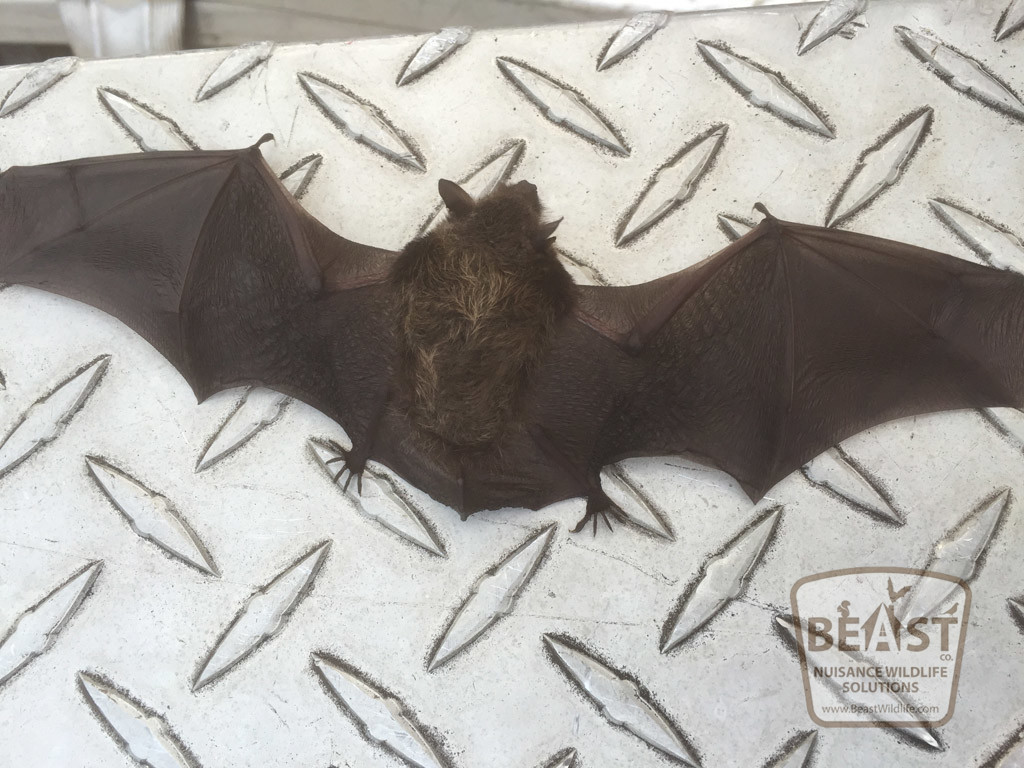Bats in torpor during the winter season, is similar to a state of hibernation. Their heart rates drop considerably to conserve energy and calories. Bats in North America eat a diet primarily comprised of flying insects, and as most mid-westerners know, flying insects are not prevalent during winter. Thus, any attempts made to evict bats from a house or building during the winter season would be futile for the most part, until temperatures are above 40/50 degrees on a nightly consecutive basis. It is also difficult to locate and seal off secondary or potential bat entry points on structures in the winter due to ice and snow. If feasible, all secondary entry points can be sealed leaving open the primary entrance points for one way devices in the spring.
During periods Of extreme cold or warm spells and high winds in winter, and during the juvenile pup season between June 1st – August 15th, it is common to have a bat find its way into the living space. When this arises, it is typically only one or two bats which have moved from the attic/ wall/ or ceiling areas and found a small gap or void where air flow leaded them into the living areas.
Bats in Minnesota typically give birth and rear the flightless young between June 1st- August 15th. During this time, we do not install one way eviction devices for bats. This is due to the young being unable to fully fly and fend for themselves. If the Adult bats are evicted and the juveniles remain within, it is possible they will die or be forced to find their way into the living areas of the structure searching for the adults/ food. Which would obviously be a liability issue for any nuisance wildlife company providing these services.
The Black Out Period is the time when young bats are flightless. While many believe the Black Out Period is only to protect bats in truth is provides benefits for homeowners.
Young bats trapped within home can make their way into living areas of home, die in wall resulting in odors and female bats are invested in young as they only have one or two young per year and will seek entry through open doors, hang on window screens etc.
Thus, we are able to seal most secondary entrance points for bats on a structure, but we wait until after the juvenile bat season (after August 15) to install the one way devices on the house/ structure.
Professionals in the wildlife control industry will always follow standards including Black Out Period for clients protection.
Live bat in living space
It is recommended to attempt to quarantine the bat in a single room if feasible, and close all other potential entry ways into other rooms. When a bat makes its way into the living space- make every reasonable attempt to keep visual contact with the bat at all times, due to the nature of bats being able to hide rather well.
Contact us for emergency removal pricing options (this varies based on location, time/ date, and areas the bats are in). Although we cannot guarantee to locate the bat (if it went back in a wall void/etc), we make recommendations about temporarily sealing the interior areas so it hopefully won’t happen again, and until we can provide an exterior bat exclusion quote for our client.
If the bat cannot be located- contact your healthcare provider regarding the next proper steps to take concerning rabies and similar issues. We cannot provide clients or the public with recommendations about rabies shots.
Our Policy- When we are hired to remove rouge bats from the interior living space, and they are physically captured, we bring them in to the university for rabies testing.
If you as the property owner decide to capture the bat yourself, we recommend you educate yourself on the proper ways to capture a bat, and submit it for testing. Bat conservation international, and CDC websites have some informative information on their sites about this.
Bat inspections
The inspection can take between 1 to 3 hours on most structures. We check soffits, fascia, eves, roof line, roof vents, chimney tops, brick and mortar joints, exhaust vents, flashing, trim, gable vents, accessible attic space, holes around pipes, miscellaneous voids and gaps, and any other potential areas on the structure . We determine the main entry areas, and possibly secondary areas. Providing a line itemized quote for exclusion work.
We exclude primarily with metal and high grade elastic sealants. We don’t utilize expandable foam products because it breaks down in weather, UV rays, and wildlife can chew thru it. We cut, bend and fabricate our metal to the area we’re excluding at. Prices for exclusion work vary on three factors. First is how many stories it is. Typically the higher off the ground, the higher the price. Second is the pitch of the roof, Substrates, the components of the building materials (what it’s made of ). Third is landscaping, if you have trees, bushes, plants, flowers, or if your landscaping is hilly; if there are fences to deal with for lifts and ladders to get around/ etc. All these are factors for the safety of our technicians and their ability to access the exclusion areas.
We send line itemized paperless quotes via email.

